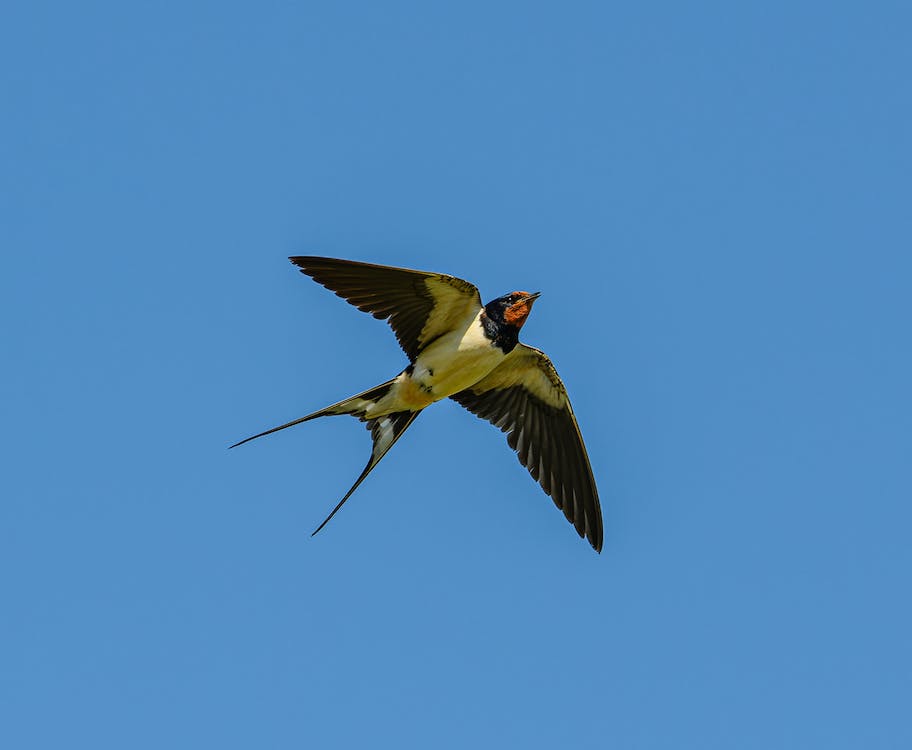It is a distinctive passerine bird, easily recognizable with its metallic or steel-blue upperparts, rufous forehead, chin and throat, orange-buff breast and belly, and incredibly long forked-tail. It is highly adaptable, now nesting in near human settlements under docks, in barns, and on buildings and bridges. These birds are common and stable throughout its vast range, making it the most widespread swallow species in the world.
Read further to know more about the Barn Swallow.
What is a Barn Swallow?
Barn Swallow (Hirundo rustica) is a small passerine bird belonging to the family Hirundinidae. It is found in Europe, Asia, America, and Africa. It is a resilient bird, that only needs open country where it can forage and eat preferred insects, and suitable nesting sites, now almost always man-made infrastructures. Citing its vast range implies that the bird is not endangered, but declines in population in certain local regions may occur due to specific threats.
Its seven levels of classification are as follows:
Kingdom: Animalia
Phylum: Chordata
Class: Aves
Order: Passeriformes
Family: Hirundinidae
Genus: Hirundo
Species: H. rustica
Barn Swallow Physical Description
Barn Swallows are small passerine birds, growing from 5.7 inches to 7.8 inches or 14.6 to 19.9 centimeters, weighing about 17 to 20 grams, with a wingspan of 12.5 to 13.5 inches or 31.8 to 34.3 centimeters.
Their plumage is metallic or steel blue above, with a rufous forehead, chin and throat, and orange-buff breast and belly. The rest of their head is deep blue, stretching in a line across the eyes, resembling a mask. The tail is conspicuous, long, slender, and forked. Both sexes look similar but have relatively shorter tails, and less glossy. Meanwhile, juveniles and immature birds appear identical to the adults but lack the long tail streamers.
Where can they be spotted?
Barn Swallows are native in all regions, except for Antarctica and Australia. Their original habitats are deemed to be seacoasts, hollow trees, caves, and rock crevices, but have adapted to areas with human settlements. They thrive in open areas, where there’s enough food items, water sources, and any suitable nesting site, such as bridges, buildings, barns, eaves of houses, docks, and even on slow-moving trains.
Interesting Facts You Should Know About the Barn Swallow
Barn Swallows are insectivorous birds, feeding mainly on insects, such as beetles, bees, wasps, ants, moths, grasshoppers, and flies. They pursue prey while on the wings, chasing them in a zig-zag pattern, and get water while also in flight, skimming over the water’s surface and scooping it with its bill. Occasionally, they may also feed on berries, seeds, and pick oysters and eggshells disposed of by humans. As a highly gregarious species, they occur in large groups, perching on elevated structures and telephone wires.
Barn Swallows are monogamous, but copulations outside the pair may happen, making the species technically polygamous. Breeding pairs are formed every spring after arrival on the breeding site. Males attract the female by spreading their forked-out tails, accompanied by singing.
The nest is a cup-shaped, made of mud, lined with feathers and grass. These swallows collect mud, spooling it into a pellet form before carrying it back to the nesting site. As its name suggests, barns are their favorite nesting location, with 5 to 8 pairs that can be seen using a single barn as their nesting area.
The female Barn Swallow usually lays a clutch of 3 to 7 eggs, which both sexes incubate for about 13 to 15 days. Both parents also feed and care for the chicks, as they are born naked and helpless. Broods will stay in the nest for 20 days but may leave early should they encounter or be handled by humans. Parents will look out for the juveniles for another week after they leave the nest, guiding them back to the nesting site during the night to roost.
Barn Swallows have a vast range, and their number appears to be stable. Specific declines may be occurring due to the reduction in suitable habitats and decrease in the food supply. Nevertheless, their population is sufficient, and they are currently listed as Least Concern (LC) under the IUCN Red List of Threatened Species.
WILDLIFE PARKS AND RESERVES WHERE THIS SPECIES IS FOUND:
BOTSWANA
SOUTH AFRICA
Kalahari Gemsbok National Park
NAMIBIA
ZAMBIA
ZIMBABWE
BOTSWANA BIRDS | SOUTH AFRICA BIRDS
NAMIBIA BIRDS | ZAMBIA BIRDS | ZIMBABWE BIRDS

